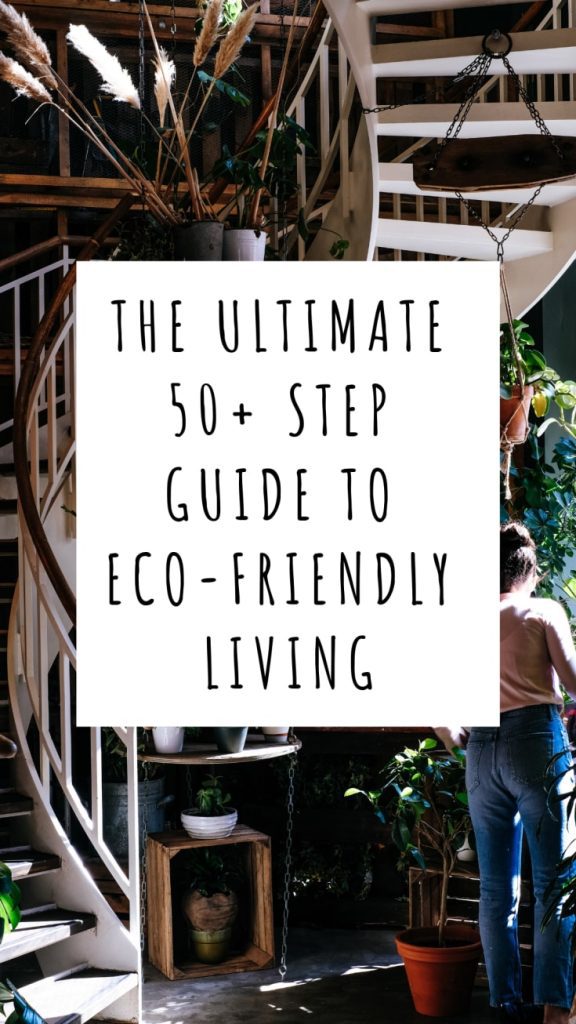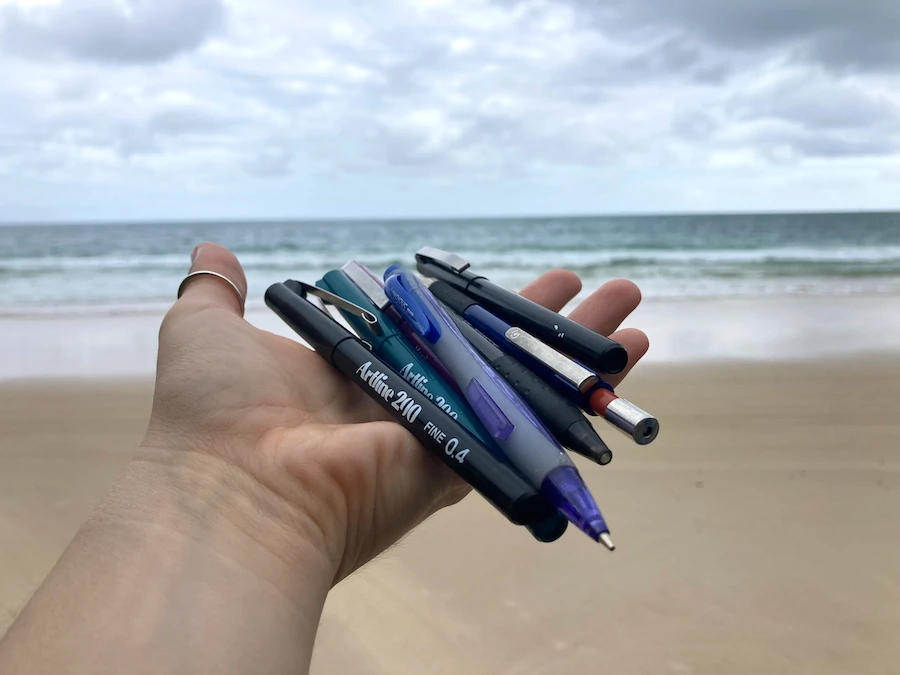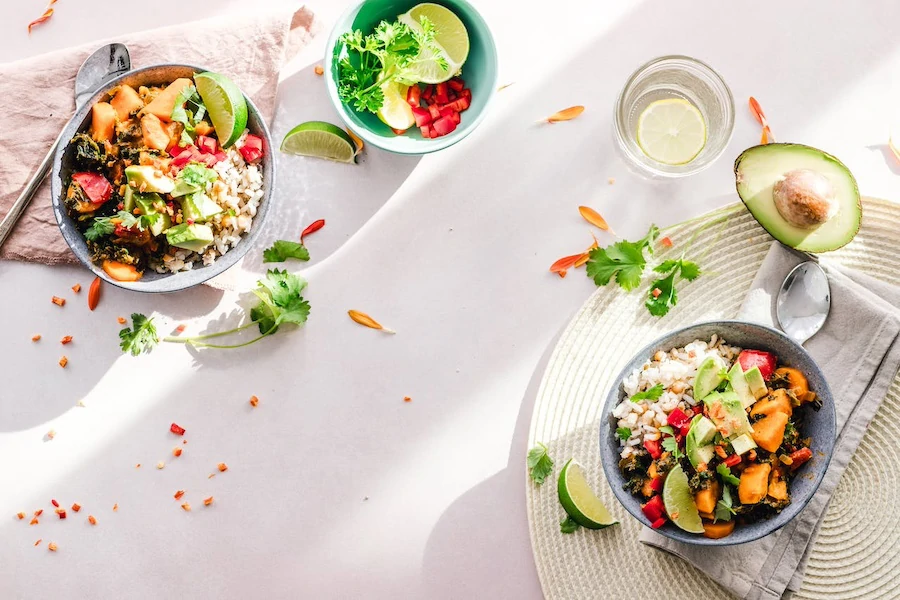
Living eco-friendly isn’t always the easiest, so sometimes we need some advice. From the kitchen to the bedroom to the office to the grocery store, there are so many ways we can decrease our carbon footprint by enacting eco-friendly habits. With environmental concerns on the rise, it’s important that we ask the question “How can I live a more eco-friendly life?”
Living a life entirely eco-friendly would be extremely difficult, so I’m not here to preach to you about living that lifestyle to a tee. What I want to do is give you some ideas of how to simply move toward a more eco-friendly life.
In my opinion, incremental change is one of the most powerful forces on earth, so just getting started and slowly improving over time can be extremely effective in the long run.
Getting a better idea of how to live an eco-friendly life is not only helpful to the environment, but it can also be fun! There are a lot of creative ways of living eco-friendly, especially if you involve your loved ones in your journey. Because in the end, practicing and spreading the word about living eco-friendly will not only improve the planet but the lives of everyone around us.
Kitchen
Replace Plastic Containers
Storing food, snacks, and liquids in plastic containers is so normal that we don’t even think about alternatives, but there are ways to go green in this category. An easy way to go about this is by using glass, bamboo, wood, or cardboard contains as alternatives to plastic. Not only will you move toward living eco-friendly, but you’ll also be avoiding any potential harm of being exposed to BPA and other plastic chemicals.
Giving up Bottled Water
Do you want to know the most common plastic found in the garbage today? The winner goes to plastic bottles, especially plastic water bottles! The number of plastic bottles that don’t get recycled is staggering, so any reduction in using them is a major step forward for living eco-friendly. Instead of plastic bottles, give reusable glass or metal water bottles a try. Their extremely eco-friendly and often times stylish!
Reuse Plastic Bags
It doesn’t take much convincing that we use a lot of plastic bags in our everyday lives. Whether you use them for grocery shopping or have hundreds stored underneath the sink, a great strategy to living eco-friendly is to reuse your plastic bags. Most of us probably use them inside small garbage bins, which is great. Discover how you can creatively reuse plastic bags in your life today!
Bamboo Cutting Boards and Serving Trays
Plastic cutting boards and serving trays have become very popular because they last a long time and they’re rather inexpensive. However, a more stylish and eco-friendly material definitely goes to bamboo. Bamboo is one of the most renewable, eco-friendly materials on the planet and the more we replace plastic with bamboo the better. Also, using plastic cutting boards can result in potentially mixing plastic shavings in your food, which is definitely not good.
Get Rid of Non-Stick Cookware
It may come as a shock to you, but using non-stick cookware like Teflon can often result in traces of plastic being transferred to your food. The material that makes metal cookware non-stick is a type of plastic and over time it can degrade and seep into your food. That’s why I always suggest that my friends and family stick to stainless steel or cast iron cookware, especially if their non-stick cookware is old.
Natural Beeswax Wraps Instead of Plastic Cling Wrap
I used to use plastic cling wrap (aka Siran wrap) on a daily basis, and when I realized how harmful it is to the environment, I decided to stop using it. The problem with plastic cling wrap is that it’s made out of plastic and it’s not recyclable, resulting in it ending up in a landfill somewhere. A great alternative is natural beeswax wrap. It’s not only eco-friendly but a really effective method for keeping your food fresh.
Bedroom
Extremely Durable and Soft Bamboo Bed Sheets
Like many people, for years my family and I were using nothing but cotton for our bedsheets. However, once I learned that for the same price I could get bamboo bed sheets that are more durable, more breathable, antibacterial, and softer, I immediately bought bamboo bed sheets for the entire house. I promise you’ll get a better night’s sleep simply by switching from cotton to bamboo bed sheets, plus it’s far more eco-friendly!
Invest in Some Insulated Window Shades
Believe it or not, but picking the right window shades can make a big difference in the temperature in your home. This may have not been a solvable issue in the past, but nowadays there are window shades that are specifically made to look great and keep your home better insulated. This can have an immediate effect on your energy bill and move toward living eco-friendly. When warming an entire house, it’s smart to conserve energy whenever possible.
Choose a Good Mattress
It seems that not a day goes by that I don’t get advertised in some way to purchase a new mattress. However, it’s easily one of the most important items you’ll ever purchase because it has a direct effect on your sleep and overall health. If you plan on going a more eco-friendly route when buying a mattress, you definitely want to avoid memory foam as it contains a lot of harmful, non-recyclable materials. Your best bet is to buy a mattress made out of 100% natural latex, 100% fair-trade organic cotton, or cruelty-free animal hair.
If you plan on going a more eco-friendly route when buying a mattress, you definitely want to avoid memory foam as it contains a lot of harmful, non-recyclable materials. Your best bet is to buy a mattress made out of 100% natural latex, 100% fair-trade organic cotton, or cruelty-free animal hair.
Bathroom
Bar Soap over Liquid Soap
Our bathrooms are filled with things that we either use every day or almost never, but the most used is probably (and hopefully) hand soap. The problem nowadays is that a lot of it comes in the form of a plastic container, which is unfortunate because it’s just another plastic item we need to buy. An alternative would be to start buying bar soap to move toward a more eco-friendly bathroom. Most bar soap is packaged in cardboard anyway, so it’s almost always 100% plastic-free.
Reusable Razors vs Disposable Razors
It used to be the case that people would buy a razor that lasted a lifetime and simply change out the blade. However, that’s changed over the years and now we’re more accustomed to disposable razors. Unfortunately, disposable razors are often made out of plastic that never gets recycled, so sticking with a reusable razor with 100% recyclable replacement blades is an amazing way to living eco-friendly.
Toilet Paper Packaged in Non-Plastic
Toilet paper is arguably the most important thing we put to use in our bathroom, so being a bit eco-conscious about it can make a big difference. Whenever you buy toilet paper, try to make sure that it’s not packaged in plastic and that the paper is either recycled or at least is eco-friendly. With all the toilet paper we buy in our lifetimes, it’s a good idea to stay aware of what we’re buying.
Plastic-Free Feminine Hygiene Products
Unfortunately, a lot of feminine hygiene products are made with some amount of plastic, which usually ends up not being recycled or in our waterways. This doesn’t bode well for our environment, especially if we’re trying to live a more eco-friendly life. One way to fix this is to invest in some biodegradable feminine hygiene products that are plastic-free. They’re not only green and eco-friendly but extremely supportive.
Try Using Bamboo Toothbrushes
This has been a growing trend for some time, but switching from plastic toothbrushes to bamboo toothbrushes is definitely here to stay! Most toothbrushes today are mostly made out of plastic and generally end up in the trash. That’s not too eco-friendly if you ask me. However, bamboo toothbrushes are 100% naturally biodegradable and antibacterial, so you can easily recycle them when you’re done to continue living eco-friendly. Not only that, but they look super stylish and unique!
Avoid Anything in Plastic Bottles
Let’s face it, our bathroom is filled with plastic bottles and containers. All kinds of plastic bottles in our bathroom, including hand soap, shampoo, conditioner, face wash, facial creams, and the list goes on. The next time you buy any of these products from your local store, consider buying products using containers made out of biodegradable and recycled materials. If we must use plastic, we might as well make sure we move in the greener direction.
Drop Those Micro-Beads
Micro-beads found in facial products and toothpaste are one of the most impossible products to recycle since these little beads go right down the drain. Sadly, they end up in our waterways and soil causing pollution and degraded lives for our animal friends as well as for us. Micro-beads cannot be recycled, so finding alternatives to any product that doesn’t use them is a huge step toward living eco-friendly.
Around the House
Cleaning with Baking Soda and Vinegar
While this may be surprising to some, cleaning around the house using baking soda and vinegar is incredibly effective and eco-friendly. The fact is that most household cleaning products contain a ton of chemicals that are not environmentally or human-friendly and they’re almost always inside plastic containers. I use baking soda and vinegar all the time when cleaning my cutting boards and kitchen counters, so give it a try!
Fix Broken Items
We live in such a throwaway culture nowadays that we’ve become very wasteful people at times. That’s why it’s important to try to preserve the products you own by fixing them if they ever break. If it’s a plate, superglue it. If some clothes have holes, sew them up. If your stereo stops working, take it to a repair shop. There are a lot of ways to avoid simply throwing things away, so the next time something in your house is broken, find out if it’s fixable before tossing it.
Try out Used Furniture
Buying new furniture can be a lot of fun, but it can also be very expensive and wasteful in terms of the materials used. Personally, I buy secondhand furniture only if it makes sense, so I’m not a purist here. For example, I wouldn’t buy a used couch, mattress, or anything made out of fabric. However, I definitely would buy a used coffee table, nightstand, shelves, or a TV stand. This is not only living eco-friendly but it can add a lot of character to your home!
Choose Low-VOC or Non-VOC Paint
When painting the interior of your home, one of the most important eco-friendly decisions you can make is to use low- or non-VOC paint. VOC stands for Volatile Organic Compound, which helps it stay wet for longer to help those painting to have more time to use it. The problem is VOCs contain harmful chemicals and are definitely not eco-friendly.
Go with Non-Toxic Floor Coverings
It’s very common to have certain floors in our homes carpeted and some not. The problem with a lot of carpeted flooring is that they may contain toxic elements, including fibers, dyes, padding, adhesives, and stain-resistant chemicals. Also, they can often time be coated with plastic material to preserve their color and structure. When getting new flooring, consider bamboo, linoleum, tile, wood, and reclaimed hardwood.
Better Insulated Doors and Windows
A lot of homes are being built with insulated, eco-friendly doors and windows, which keeps heat inside. This means saving energy and money on a daily basis. Some older homes (including mine) don’t come with these insulated products by default, so adding them to our homes is important. Being energy efficient not only helps our environment, but it also helps our wallets.
Parties
Say No to Plastic Straws
It’s amazing to imagine how many straws the world uses on a daily basis since they’re used all the time at restaurants and parties. The sad part about plastic straws, however, is that they’re often non-recyclable and are used only one time. But there’s a solution! Some amazing alternatives to include reusable drinking straws and bamboo drinking straws. Cleaning them is a breeze and they look great at any party!
Disposable Bamboo Dishes and Utensils
No one wants to clean up a bunch of dishes after a BBQ or holiday party, so using disposable dishes and cutlery is a must. However, disposable plastic dishes and utensils are very wasteful and can be easily replaced with disposable bamboo dishes and utensils. Not only is bamboo eco-friendly, but it’s incredibly stylish. There’s no doubt they’ll be noticed and talked about at your next party.
Biodegradable Party Cups
Party cups are ubiquitous when it comes to parties, but sadly those red plastic cups usually end up straight in the garbage and to a landfill. An alternative would be to start using 100% naturally biodegradable party cups so that you can ensure your parties are green every time.
Paper table covers
If you’re throwing a party, then it’s likely that someone’s going to spill something on a table somewhere. No one wants their fine cloth to catch any of these spills, so using a disposable table cover is definitely the way to go. However, most disposable table covers have plastic weaved into the fabric, which makes it no longer recyclable. Instead, opt for paper table covers whenever you get the chance.
Pets
Avoid Plastic Food and Water Bowls
Now you might know by now that I’m not a huge fan of plastic around my family, and that’s no different when it comes to our family pets. All of my dogs use non-plastic food and water bowls to ensure they’re not exposed to any harmful plastic-based chemicals, like BPA. My favorite food and water bowls are made out of bamboo, which is a very effective solution when moving toward living eco-friendly.
Buy Plastic-Free Toys
The less plastic we expose ourselves to on a daily basis the better, and this goes for our animal friends as well. As opposed to toys for people, animal toys are under much less scrutiny when it comes to harmful chemicals and strange plastics. The sad part about all of this is that most products aimed at pets contain some level of plastic, so keeping an eye out is important.
Make a Dog Bed Stuffed with Used Plastic Bags
With all of the plastic bags we collect over the years, it’s always nice to find more ways to use them. One popular method for reusing plastic bags in a creative way is to use it as stuffing for your pet’s bed. Whether the padding in their bed is getting flatter or you simply want to replace all of it, reusing plastic bags is an effective and inexpensive way to create padding. This is not only super convenient and cheap but a very good way of living eco-friendly for you and your pets.
Car
Speeding Wastes Gas
It’s a known fact that when you speed while driving your car, you’re decreasing your miles per gallon (or kilometers per liter) drastically. Staying around the prescribed speed limits definitely helps you reduce the use of petroleum on a daily basis, which is most definitely beneficial to the environment. Also, it keeps the roads safer for yourself and others.
Keep Tires Properly Inflated
When the tires on your car aren’t inflated to their proper levels, it’s definitely the case that your losing efficiency on your gas-use. The reason for this is due to the fact that more surface area of your tire is touching the road, resulting in more friction between your tires and the road. This inherently slows your car down and doesn’t allow it to cruise as easily. Another simple tip for living eco-friendly.
Make Sure Your Car Gets Regular Checkups
It’s important to keep your car in good shape so that you don’t get into any sticky situations while driving. An important way to avoid this is by getting regular checkups (I do it once every 6 months). That’ll not only ensure your car is being serviced properly, but it’ll also ensure that your oil is changed and your tires are inflated properly. Definitely an eco-friendly way to go!
Try Keeping the RPMs Low
Apart from speeding, keeping your RPMs low is an important way to reduce the use of gas and thus carbon pollution. When you drive your car at high RPMs, it’s working harder than it needs to when instead you could likely switch to a higher gear. This allows you to use the momentum you’ve already built while getting up to speed, which allows you to conserve and better use the energy produced from the gas your car burns.
Start a Carpool
Who doesn’t want fewer cars on the road? The number of cars on the road with only one person is tremendous, so having the opportunity to share with others can have a huge impact on the health of our planet. Not only will you burn fewer fossil fuels when carpooling, but you’ll have more time to relax since another person will be driving. Whether you’re carpooling for work or your children’s’ soccer matches, this is a great way to ensure you’re living eco-friendly!
Consider Public Transportation
Similar to carpooling, using public transportation when it’s convenient is a huge positive to decreasing the congestion on our roads as well as reducing the use of fossil fuels. Now, if you’re traveling really long distances and it’s not very convenient to take public transportation, you’re probably better sticking with your car. But if you have an opportunity to do it, try it out. You might like it!
Take a Walk
I’m guessing a commonly overlooked method of replacing your car is simply by walking. Let’s face it, not every occasion requires the use of a car. If you live a couple of blocks from where you need to go, why not just take a walk? Getting that fresh air while avoiding the hassle of driving your car can be very therapeutic. Along with that, it’s also good for you and the environment!
Clothing
Wear Natural Fibers and Recycled Materials
Most of the clothes we wear on a daily basis are most likely made out of cotton, which, unless it’s fair-trade and organic, isn’t the most eco-friendly fabric out there. The problem with cotton is that it requires the use of harmful chemicals to process and a lot of water and pesticides to grow. Arguably the best alternatives out there include clothing made out of bamboo, hemp, linen, recycled polyester, soy silk and cashmere, and cruelty-free wool.
Shop at Thrift Stores
When I was a kid, it was all too common to take a Saturday adventure to the local thrift store. There were not only a bunch of inexpensive toys to buy but well-maintained, quality clothes. Nowadays, I don’t fill my wardrobe too heavily with secondhand clothes, but from time to time I find some nice gems. But there’s no doubt I take my children there to get clothes that they’ll most likely destroy or outgrow in the next months!
Learn How to Patch up Holes in Clothes
I wish I had learned how to sew earlier in my life because I remember just throwing away clothes that I loved but had tears in them. However, once I learned, I started sewing and patching up holes here and there for my clothes as well as my family’s. Not only is this a money saver in the long run, but it feels great knowing that something once broken is now fixed and could last several more years. I love that feeling!
Buy Plastic-Free Shoes
Plastic is literally everywhere we go and there’s no escaping it, especially since it’s used to make our shoes! It’s very common for the rubber on the soles of our shoes to be a mix of rubber and plastic. Since mixing these two materials automatically means they cannot be recycled, it’s a good idea to find out whether the new shoes you buy are made with this mix or not. Just another way to move toward living eco-friendly.
Shopping
Bring a Reusable Bag
Whenever I go shopping, whether it’s for groceries or clothing, it’s always the case that something will need to get bagged up. Since the default is almost always a plastic bag, I started to bring a reusable shopping bag with me wherever I go. By simply throwing a few reusable shopping bags in the back of my car’s trunk, I have something to store whatever I buy without resorting to using wasteful plastic bags.
Shop in Bulk
Something I love to do more and more nowadays is to buy grocery items in bulk from the bulk bins. This is great because I can bring my own reusable containers with me and fill them up to the level I know is sufficient for the week to come. On top of that, it’s less wasteful than buying similar food that’s been pre-packaged since I don’t have to throw away even more things at home. Plus, I like being able to eyeball the food I’m buying and scooping up!
Cut out Plastic-Bottled Beverages
Whenever I look down the beverage aisle, so many items are bottled in plastic. I mean, it’s just amazing how many there are! Over the years, I’ve been cutting out plastic bottles and replacing them with glass or cardboard-like bottles and containers when it comes to purchasing beverages from the store. That way I can recycle the bottle and try out, in my opinion, better quality drinks. And when it comes to bottled water, I always have with me my reusable water bottle.
Fresh Bread from Either Paper Bags or No Bags
There are so many brands and types of bread out there, the choices can often be overwhelming. Something I’m really happy I started doing is buying fresh bread from my local bakery and having them store it in a bread container. My entire family loves this because the quality of bread we eat now is miles ahead of the store-bought packaged bread. However, if you still want to stick to the packaged bread, consider buying the brands wrapped up in paper bags instead of plastic.
Buy Milk in Glass Containers
When I was a kid, we used to have a metal milk delivery container outside our front door where, on a weekly basis, our milkman would deliver us fresh milk. I was told this still happens, but I haven’t seen it in my neighborhood! Either way, avoiding plastic containers when buying milk at the grocery store in favor of glass bottles is a much better choice because it’s easier to recycle glass. Also, you never know what plastic materials are interacting without milk.
Wine with Natural Cork Stoppers
Now, this is where I’m still guilty from time to time, but I try my best only to buy wine that’s bottled with natural cork stoppers. Not only because I like to save the corks for DIY activities, but because the use of plastic as a cork stopper seems wasteful to me. Cork is a natural and recyclable material, so it makes sense for me to stick with the natural cork. Plus, it’s likely the wine with natural cork stoppers tastes better, but that’s just an opinion!
No More Plastic Produce Bags
I never really thought about this too much before, but those little flimsy plastic produce bags are probably more prevalent in terms of use than plastic shopping bags. I’d say they’re even worse because they’re really only good for one-time use. I try to avoid using these plastic produce bags as much as possible and instead reuse plastic bags I saved from home.
Shop at Your Local Farmers Market
I don’t know about you, but I love walking around my local farmer’s market and looking at all the food the farmers present. It’s so colorful and alive! Supporting local farmers is a great way to not only give back to your local community but also to live a more eco-friendly life. It’s easy to talk to everyone and find out just how they produce their products, which allows you to get an idea of their level of eco-friendliness. Plus the food is great and they usually package everything in reusable containers!
Bring Your Own Container for Prepared Meats
Over time, I stopped buying pre-packaged meats and started moving more toward meat prepared by our local butcher. The great part about this is that the meat is extremely fresh (and delicious!), it’s another way to support our local community, and I reduce the use of plastic on a daily basis. Also, I know that the animals used to produce the meat were treated ethically during their lives, which makes all the difference for me.
Drop Frozen Convenience Food
We all know it’s not very healthy to eat microwave TV dinners or frozen chicken sticks that take 20 minutes to heat up in the oven. Sadly, not only is this food is extremely unhealthy, but they use a lot of non-recyclable plastic to store the food. Not only that, but the source of the food is likely not of the highest quality, so who knows what process was taken to manufacture everything. I’m guessing not very high-quality.
Avoid as Much Plastic Packaging as Possible
I’m going to sound like a broken record here, but avoiding plastic packaging when going shopping can make a huge difference in terms of addressing pollution. Most plastic being used today is either non-recyclable or it’s not being recycled when it should be. Plastic is made using petroleum (aka fossil fuels), which only contributes to our planet’s pollution. On top of that, it can take up to 1000 years to biodegrade. Not very sustainable if you ask me. Just keep an eye out for non-plastic packaging options whenever you go shopping.
Entertainment and Electronics
Find Refurbished Electronics, Games, and Toys
Not only is almost everything made with some amount of plastic, but everything likely contains some amount of electronics. Now, it’s totally fine to purchase electronic devices. The problem comes down to when we simply throw them away because electronics contain rare earth metals that must be recycled properly. So the next time you buy that new and fun device, consider getting a refurbished version. Not only will it be a very eco-friendly purchase, but also much cheaper than buying it brand new!
Take Care of Your Existing Products
We live in a throwaway culture when it comes to the products we buy. The problem with that nowadays is that a lot of products contain plastic and electronics, which need to be disposed of in a particular way. Instead of simply going out and buying a replacement product when the one you own seems busted, consider finding out whether it can be fixed or not. If not, no biggie. But if it can, likely it’ll be cheaper than buying a new one and you’ll be helping the environment.
Netflix Instead of Buying DVD or Blu-Ray Discs
Let’s face it, we all like watching Netflix from time to time (or all the time!). While I still have a large collection of CDs, DVDs, and Blu-rays (and VHS!), I don’t like buying them anymore because I have everything on Netflix already. This is great because all of these media discs are made out of plastic and end up just sitting on our shelves, rarely to be watched. I never really thought Netflix to be an eco-friendly alternative to media discs, but it really is!
Recycle Electronics and Batteries Properly
One of the most common mistakes when it comes to electronics and batteries is how they’re disposed. These items contain rare earth metals which are highly limited resources and require a lot of energy to manufacture properly. Also, they can cause pollution when exposed. This is why they must be recycled properly, and not doing so can cause a lot of harm to planet earth. The next time you plan on tossing out your electronics and batteries, go to your local electronics store and ask them to recycle them for you. They almost certainly will!




